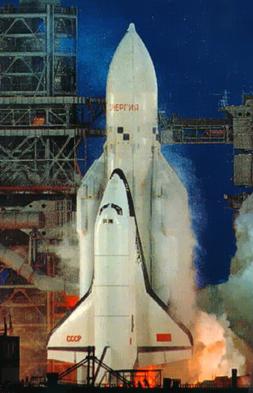31 Years Ago Today; Soviet Space Shuttle Buran makes only spaceflight, unmanned
https://tinyurl.com/822kedv Wikipedia link
 Buran at the 1989 Paris Air Show
Buran
Buran at the 1989 Paris Air Show
Buran (Russian: Бура́н, IPA: [bʊˈran], meaning "Snowstorm" or "Blizzard"; GRAU index serial number: "11F35 K1" ) was the first spaceplane to be produced as part of the Soviet/Russian Buran programme. It is, depending on the source, also known as "OK-1K1", "Orbiter K1", "OK 1.01" or "Shuttle 1.01". Besides describing the first operational Soviet/Russian shuttle orbiter, "Buran" was also the designation for the entire Soviet/Russian spaceplane project and its orbiters, which were known as "Buran-class spaceplanes".
OK-1K1 completed one uncrewed spaceflight in 1988, and was destroyed in 2002 when the hangar it was stored in collapsed. The Buran-class orbiters used the expendable Energia rocket, a class of super heavy-lift launch vehicle.
Construction
The construction of the Buran spaceplanes began in 1980, and by 1984 the first full-scale orbiter was rolled-out. Construction of a second orbiter (OK-1K2, informally known as Ptichka (meaning little bird)) started in 1988. The Buran programme ended in 1993.
Operational history
 Orbiter OK-1K1 Buran during launch on 15 November 1988
Orbital flight
Orbiter OK-1K1 Buran during launch on 15 November 1988
Orbital flight
The only orbital launch of a Buran-class orbiter occurred at 03:00:02 UTC on 15 November 1988 from Baikonur Cosmodrome launch pad 110/37. Buran was lifted into space, on an uncrewed mission, by the specially designed Energia rocket. The automated launch sequence performed as specified, and the Energia rocket lifted the vehicle into a temporary orbit before the orbiter separated as programmed. After boosting itself to a higher orbit and completing two orbits around the Earth, the ODU (Russian: объединённая двигательная установка, сombined propulsion system) engines fired automatically to begin the descent into the atmosphere, return to the launch site, and horizontal landing on a runway.
After making an automated approach to Site 251 (known as Yubileyniy Airfield), Buran touched down under its own control at 06:24:42 UTC and came to a stop at 06:25:24, 206 minutes after launch. Despite a lateral wind speed of 61.2 kilometres per hour (38.0 mph), Buran landed only 3 metres (9.8 ft) laterally and 10 metres (33 ft) longitudinally from the target mark. It was the first spaceplane to perform an uncrewed flight, including landing in fully automatic mode. It was later found that Buran had lost only eight of its 38,000 thermal tiles over the course of its flight.
Projected flights
In 1989, it was projected that OK-1K1 would have an uncrewed second flight by 1993, with a duration of 15–20 days. Although the Buran programme was never officially cancelled, the dissolution of the Soviet Union led to funding drying up and this never took place.
</snip>
Although very similar, Buran was better than the US Space Shuttle in one way, it had air-breathing jet engines to assist with landing, should power be needed in that flight phase.

